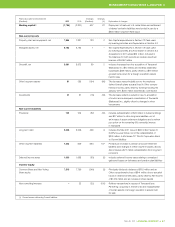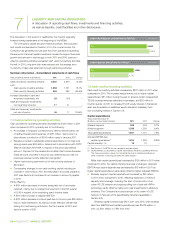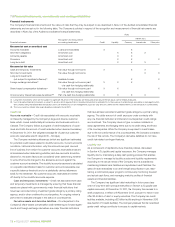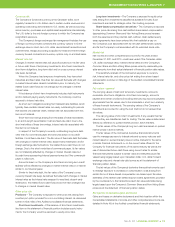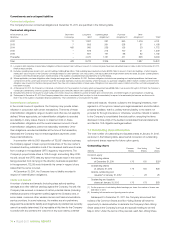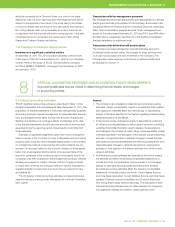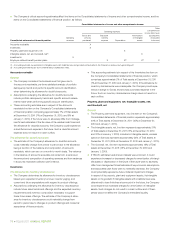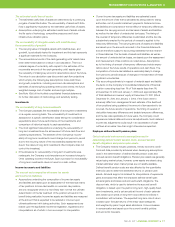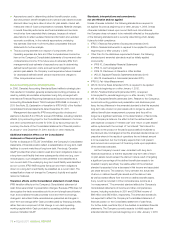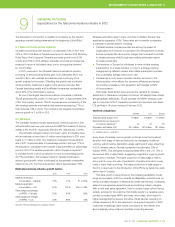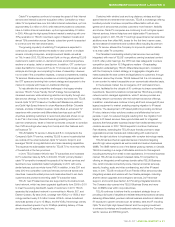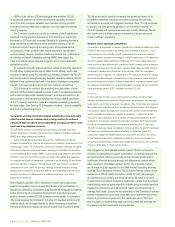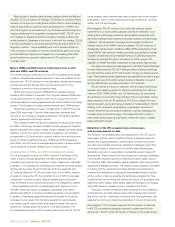Telus 2011 Annual Report Download - page 81
Download and view the complete annual report
Please find page 81 of the 2011 Telus annual report below. You can navigate through the pages in the report by either clicking on the pages listed below, or by using the keyword search tool below to find specific information within the annual report.
TELUS 2011 ANNUAL REPORT . 77
MANAGEMENT’S DISCUSSION & ANALYSIS: 8
The estimated useful lives of assets
.The estimated useful lives of assets are determined by a continuing
program of asset life studies. The recoverability of assets with finite
lives is significantly impacted by the estimated useful lives of assets.
.Assumptions underlying the estimated useful lives of assets include
the life cycle of technology, competitive pressures and future
infrastructure utilization plans.
The recoverability of intangible assets with indefinite lives;
the recoverability of goodwill
.The carrying value of intangible assets with indefinite lives, and
goodwill, is periodically tested for impairment and this test represents
a significant estimate for the Company.
.The recoverable amounts of the cash-generating units’ assets have
been determined based on a value in use calculation. There is a
material degree of uncertainty with respect to the estimates of the
recoverable amounts of the cash-generating units’ assets given
the necessity of making key economic assumptions about the future.
The value in use calculation uses discounted cash flow projections
which employ the following key assumptions: future cash flows
and growth projections, including economic risk assumptions and
estimates of achieving key operating metrics and drivers; the future
weighted average cost of capital; and earnings multiples.
.See Note 16(d) of the Audited consolidated financial statements
for further discussion of methodology and sensitivity testing.
Investments
The recoverability of long-term investments
.The Company assesses the recoverability of its long-term investments
on a regular, recurring basis. The recoverability of investments is
assessed on a specific identification basis taking into consideration
expectations about future performance of the investments and
comparison of historical results to past expectations.
.The most significant assumptions underlying the recoverability of
long-term investments are the achievement of future cash flow and
operating expectations. The estimate of the Company’s recover-
ability of long-term investments could change from period to period
due to the recurring nature of the recoverability assessment and
due to the nature of long-term investments (the Company does not
control the investees).
.If the allowance for recoverability of long-term investments were
inadequate, the Company could experience an increased charge to
Other operating income in the future. Such a provision for recoverability
of long-term investments does not result in a cash outflow.
Income tax assets and liabilities
The amount and composition of income tax assets
and income tax liabilities
.Assumptions underlying the composition of income tax assets
and liabilities are based upon an assessment of the technical merits
of tax positions. Income tax benefits on uncertain tax positions
are only recognized when it is more likely than not that the ultimate
determination of the tax treatment of the position will result in the
benefit being realizable. Income tax assets and liabilities are measured
at the amount that is expected to be realized or incurred upon
ultimate settlement with taxing authorities. Such assessments are
based upon the applicable income tax legislation, regulations and
interpretations, all of which in turn are subject to interpretation.
.Current income tax assets and liabilities are estimated based
upon the amount of tax that is calculated as being owed to taxing
authorities, net of periodic instalment payments. Deferred income
tax liabilities are comprised of the tax effect of temporary differences
between the carrying amount and tax basis of assets and liabilities
as well as the tax effect of undeducted tax losses. The timing of
the reversal of temporary differences is estimated and the tax rate
substantively enacted for the periods of reversal is applied to the
temporary differences. The carrying amounts of assets and liabilities
are based upon the amounts recorded in the financial statements
and are therefore subject to accounting estimates that are inherent
in those balances. The tax basis of assets and liabilities, as well as
the amount of undeducted tax losses, are based upon the assessment
and measurement of tax positions as noted above. Assumptions
as to the timing of reversal of temporary differences include expec-
tations about the future results of operations and cash flows. The
composition of income tax liabilities is reasonably likely to change
from period to period because of changes in the estimation of these
significant uncertainties.
.This accounting estimate is in respect of material asset and liability
line items on the Company’s Consolidated statements of financial
position comprising less than 1% of Total assets (less than 1%
at December 31, 2010 and January 1, 2010) and approximately 8%
of Total liabilities and owners’ equity at December 31, 2011 (9% at
December 31, 2010 and January 1, 2010). If the future were to
adversely differ from management’s best estimate of the likelihood
of tax positions being sustained, the amount of tax expected to be
incurred, the future results of operations, the timing of reversal of
deductible temporary differences and taxable temporary differences,
and the tax rates applicable to future years, the Company could
experience material deferred income tax adjustments. Such deferred
income tax adjustments could result in an acceleration of cash
outflows at an earlier time than might otherwise be expected.
Employee defined benefit pension plans
Certain actuarial and economic assumptions used in
determining defined benefit pension costs, accrued pension
benefit obligations and pension plan assets
.The Company reviews industry practices, trends, economic condi-
tions and data provided by actuaries when developing assumptions
used in the determination of defined benefit pension costs and
accrued pension benefit obligations. Pension plan assets are generally
valued using market prices, however, some assets are valued using
market estimates when market prices are not readily available.
Defined benefit pension costs are also affected by the quantitative
methods used to determine estimated returns on pension plan
assets. Actuarial support is obtained for interpolations of experience
gains and losses that affect the employee defined benefit plan
actuarial gains and losses and accrued benefit obligations. The
discount rate, which is used to determine the accrued benefit
obligation, is based upon the yield on long-term, high-quality fixed-
term investments, and is set annually at the end of each calendar
year, based upon yields on long-term corporate bond indices in
consultation with actuaries. The expected long-term rate of return
is based upon forecast returns of the major asset categories
and weighted by plans’ target asset allocations. Future increases
in compensation are based upon the current benefits policies
and economic forecasts.


